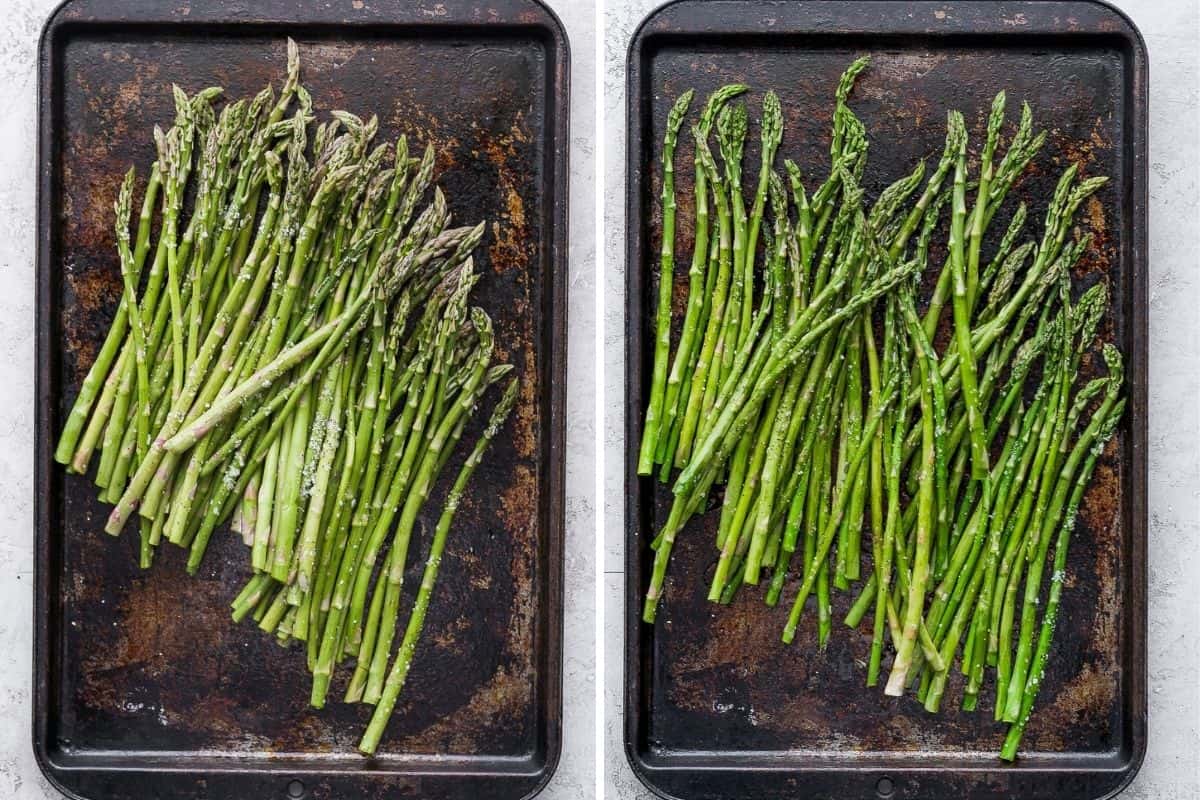This post may contain affiliate links. Please read our disclosure policy.
Here are two easy ways to cook asparagus. We’ll show you how to prepare asparagus on the stovetop and in the oven. Nothing screams spring like this popular green vegetable. It’s perfect to serve on the side of chicken or salmon, or tossed in a pasta dish.

Asparagus is awesome! One unadorned serving has only about 20 calories yet contains about six percent of the recommended daily amount of fiber, plus vitamin A, B9 – or folate (vital for expecting moms)!
How to cook asparagus
The first step for either method is washing the asparagus then cutting off the woody bottoms. If your batch is especially woody at the bottom, shave some of the outside bottom layers with a vegetable peeler in addition to trimming the ends.

Stovetop instructions
- Prepare a pot of water with salt. Bring it to a boil. If serving the asparagus cold or reheating, prepare an ice bath to shock the asparagus after cooking.
- Carefully place trimmed asparagus in boiling water and simmer until tender.

- Toss with olive oil, salt, and pepper. A squeeze of lemon is also lovely as is a sprinkle of parmesan cheese.
- Serve immediately so you can enjoy their crispness.

Oven instructions
- Toss asparagus in olive oil and a pinch of salt and black pepper. You can add more seasoning if you’d like but it really doesn’t need more.

- Place the asparagus on a roasting pan and put it in the oven; it’s ok if they’re overlapping but you can spread it as much as possible.
- Roast until tender and slightly colored. Note that thicker stalks will take longer.

Tips for choosing and cooking asparagus
- Look for asparagus with bright green color -unless you are buying white or purple varieties.
- Choose asparagus that have tightly budded firm tips and firm stalks. Those will be the most fresh.
- Don’t worry about the size of asparagus. The thin ones are not necessarily more tender. They just come from younger plants and they will cook faster. Thicker asparagus will take longer to cook. On the upside, they are harder to overcook.
- Be careful not to overcook. Whichever method you choose, it’s important to note that the cook times are really quick so don’t go too far from the kitchen and keep an eye on them. That way they stay crisp and don’t get soggy.
Recipes using asparagus
- Dairy-Free Asparagus Soup
- Crusted Salmon with Asparagus
- Vegetarian Frittata
- Goats Cheese and Asparagus Canapés
- Shrimp and Asparagus Sheet Pan Dinner
- Chickpea and Roasted Asparagus Cous Cous Salad
- Air Fried Asparagus
- Garlic Herb Chicken and Asparagus
- Baked Asparagus Dip
Frequently asked questions
Fresh asparagus lasts 3 to 4 days in the fridge. Cooked will be good for three to five days and can be frozen and reheated.
Although usually available year-round, asparagus’s best season is late winter through spring. It usually peaks in April.
Yes, after cooking, you can freeze asparagus for up to 2 months. Make sure to seal it in an airtight container or wrap tightly in foil or freezer wrap. You can reheat in the oven for 1-2 minutes until warmed through.

After a long winter, there is nothing brighter than some fresh asparagus on your plate! Use these basic stovetop and oven roasting directions and customize with different spices and different ways of serving.
More cooking tutorials:
- How to Make Caramelized Onions
- How to Make Your Own Pizza Dough
- How to Boil Eggs
- How to Make Dressing
- How To Cook Pasta
- How To Make Oat Flour
- How to Make Pesto
If you’ve found this cooking resource for How to Cook Asparagus helpful or if you’ve tried any recipe on FeelGoodFoodie, then don’t forget to rate the recipe and leave me a comment below! I would love to hear about your experience with this technique. And if you snapped some shots of it, share it with me on Instagram so I can repost on my stories

order MY book
The Feel Good Foodie Cookbook is now available everywhere books are sold!
Amazon TargetBarnes & Noble Books A Million Hudson Booksellers BookshopSCHULER Books

How to Cook Asparagus
Ingredients
- 1 bunch asparagus medium to large thickness
- Olive oil
- Salt and pepper
Instructions
Stovetop Instructions
- Prepare a pot of 8 cups water with 2 tablespoons coarse salt and bring to a boil
- If serving the asparagus cold or reheating, prepare an ice bath to shock the asparagus when done
- Using a large chef knife or kitchen shears, trim the bottoms of the asparagus removing the tough white stems
- Carefully place asparagus in boiling water and simmer for 3-4 minutes or until tender
- Once tender, carefully remove or strain the asparagus, and then toss with olive oil, salt, and pepper
Oven Instructions
- Preheat oven to 425°F
- Toss asparagus in olive oil and a pinch of salt and black pepper
- Place the asparagus on a roasting pan and place in the oven
- Roast until tender and slightly colored, about 3-4 minutes
- Serve immediately.
Notes
Nutrition
Nutrition information provided is an estimate. It will vary based on cooking method and specific ingredients used.





